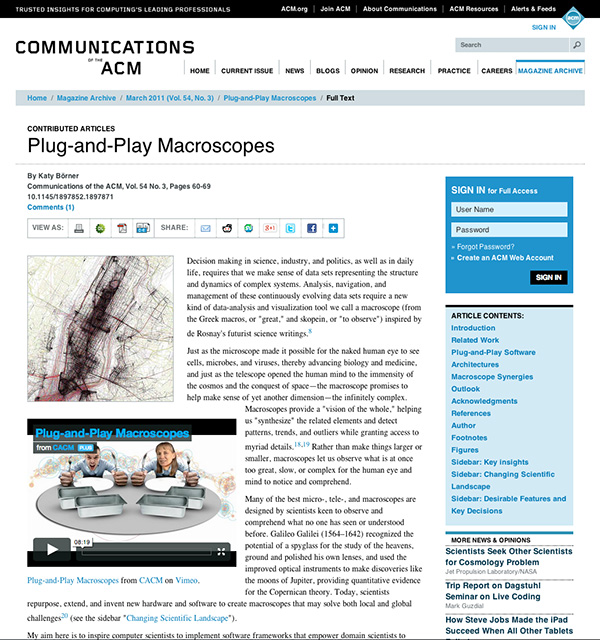Plug-and-Play Macroscopes (website accessed 03/01/2011)
| Katy Börner | Communications of the ACM

The following is an excerpt from an article in Communications of the ACM. Read the full, original article on the web here, or download a PDF of the article here.
Decision making in science, industry, and politics, as well as in daily life, requires that we make sense of data sets representing the structure and dynamics of complex systems. Analysis, navigation, and management of these continuously evolving data sets require a new kind of data-analysis and visualization tool we call a macroscope (from the Greek macros, or "great," and skopein, or "to observe") inspired by de Rosnay's futurist science writings.
Just as the microscope made it possible for the naked human eye to see cells, microbes, and viruses, thereby advancing biology and medicine, and just as the telescope opened the human mind to the immensity of the cosmos and the conquest of space—the macroscope promises to help make sense of yet another dimension—the infinitely complex. Macroscopes provide a "vision of the whole," helping us "synthesize" the related elements and detect patterns, trends, and outliers while granting access to myriad details.18,19 Rather than make things larger or smaller, macroscopes let us observe what is at once too great, slow, or complex for the human eye and mind to notice and comprehend.
Many of the best micro-, tele-, and macroscopes are designed by scientists keen to observe and comprehend what no one has seen or understood before. Galileo Galilei (1564–1642) recognized the potential of a spyglass for the study of the heavens, ground and polished his own lenses, and used the improved optical instruments to make discoveries like the moons of Jupiter, providing quantitative evidence for the Copernican theory. Today, scientists repurpose, extend, and invent new hardware and software to create macroscopes that may solve both local and global challenges20 (see the sidebar "Changing Scientific Landscape").
My aim here is to inspire computer scientists to implement software frameworks that empower domain scientists to assemble their own continuously evolving macroscopes, adding and upgrading existing (and removing obsolete) plug-ins to arrive at a set that is truly relevant for their work—with little or no help from computer scientists. Some macroscopes may resemble cyberinfrastructures (CIs),1 providing user-friendly access to massive amounts of data, services, computing resources, and expert communities. Others may be Web services or standalone tools. While microscopes and telescopes are physical instruments, macroscopes resemble continuously changing bundles of software plug-ins. Macroscopes make it easy to select and combine algorithm and tool plug-ins but also interface plug-ins, workflow support, logging, scheduling, and other plug-ins needed for scientifically rigorous work. They make it easy to share plug-ins via email, flash drives, or online. To use new plug-ins, simply copy the files into the plug-in directory, and they appear in the tool menu ready for use. No restart of the tool is necessary. Sharing algorithm components, tools, and novel interfaces becomes as easy as sharing images on Flickr or videos on YouTube. Assembling custom tools is as quick as compiling your custom music collection.
The macroscopes presented here were built using the Open Services Gateway Initiative Framework (OSGi) industry standard and the Cyberinfrastructure Shell (CIShell) that supports integration of new and existing algorithms into simple yet powerful tools. As of January 2011, six different research communities were benefitting from OSGi and/or CIShell powered tools. Several other tool-development efforts consider adoption.
Read the full article on the web here, or download a PDF of the article here.





